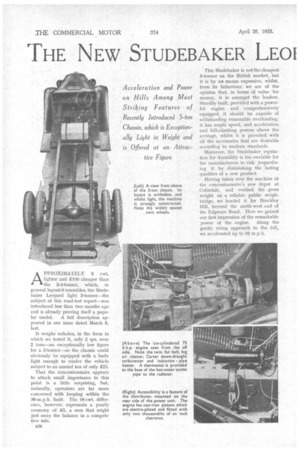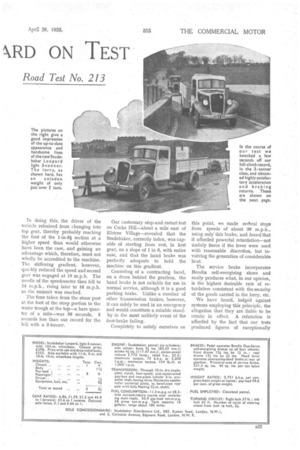THE NEW STUDEBAKER LE01 RD ON TEST
Page 44

Page 45

Page 46

If you've noticed an error in this article please click here to report it so we can fix it.
Acceleration and Power on Hills Among Most Striking Features of Recently Introduced 3-ton Chassis, which is Exceptionally Light in Weight and is Offered at an Attrac
tive Figure
APPROXIMATELY 8 cwt. lighter and £100 cheaper than the 3-4-tonner, which, in general layout it resembles, the Studebaker Leopard light 3-tonner—the subject of this road-test report—was introduced less than two months ago and is already proving itself a popu lar model. A full description appeared in our issue dated March 8, last.
It weighs unladen, in the form in which we tested it, only 2 qrs. over 2 tons—an exceptionally low figure for a 3-tonner---so the chassis could obviously be equipped with a body light enough to render the vehicle subject to an annual tax of only £25.
That the concessionnaire appears to attach small importance to this point is a little surprising, but, naturally, operators are far more concerned with keeping within the 0-m.p.h. limit The 10-cwt. difference, however, represents a yearly economy of £5, a sum that might just sway the balance in a competitive sale.
B26 In doing this, the driver of the vehicle refrained from changing into top gear, thereby probably reaching the foot of the section at a higher speed than would otherwise have been the case, and gaining an advantage which, therefore, must not wholly be accredited to the machine. The stiffening gradient, however, quickly reduced the speed and second gear was engaged at 19 m.p.h. The needle of the speedometer then fell to 14 in.p.h., rising later to 16 m.p.h. as the summit was reached.
The time taken from the stone post at the foot of the steep portion to the water trough at the top—a bare quarter of a mile—was 50 seconds, 5 seconds less than our record for the bill with a 3-tonner. Our customary stop-and-restart test on Cocks Hill—about a mile east of Elstree Village—revealed that the Studebaker, correctly laden, was capable of starting from rest, in first gear, on a slope of 1 in 6, with entire ease, and that the hand brake was perfectly adequate to hold the machine on this gradient.
Consisting of a contracting band, on a drum behind the gearbox, the hand brake is not suitable for use in normal service, although it is a good parking brake. Unlike a number of other transmission brakes, however, it can safely be used in an emergency and would constitute a reliable standby in the most unlikely event of the foot-brake failing.
Completely to satisfy ourselves on
this point, we made see,ral stops from speeds of about 30 m.p.h., using only this brake, and found that it afforded powerful retardation—not unduly fierce if the lever were used with reasonable discretion, but involving the generation of considerable heat.
The service brake incorporates Bendix self-energizing shoes and easily produces what, in our opinion, is the highest desirable rate of retardation consistent with the security of the goods carried in the lorry, etc.
We have heard, lodged against systems employing this principle, the allegation that they are liable to be erratic in effect. A refutation is afforded by the fact that our tests produced figures of exceptionally good consistency, the distance curve in the accompanying graph following the course indicated by the dots from which it was plotted with an unusual degree of precision, and roughly agreeing, from the higher speeds, with the curve of 45 per cent. efficiency.
Further evidence of the capabilities of the engine is given by the accompanying acceleration graph. It will be observed that a speed of 50 m.p.h. is attainable in less than a minute from a standing start, whilst the
flexibility revealed by the top-gear curve from 10 m.p.h, is extremely good. Whilst generating 75 b.h.p. at 3,200 r.p.m. its maximum torque is developed at 1,000 r.p.m.—a desirable characteristic for r top-gear performance."
An interesting feature of the power unit,. which certainly seems to contribute to the excellence of its running and may reasonably be expected to augment its life, is that the cast-iron pistons are clectro-plated.
Another interesting feature that has much to recommend it is the use of a floating pump intake in the lubrication system, which ensures that oil is always drawn from just below the level of the liquid contents of the sump. No measure for eliminating vibration seems to have been neglected. The sturdy four-bearing crankshaft is provided with balance weights, and incorporates a torsional vibration damper, with the result that the engine runs most silkily. Indeed, as we recall mentioning after road testing a Studebaker about a year ago, it is practically impossible to tell from the driver's seat, with the controls in the idling position, whether the unit is running or not, for it is as quiet as it is vibrationless.
Our consumption test was conducted over a route that included several moderate hills, and sufficient traffic congestion to make it representative of normal operating condi tions. It was traversed in two directions, and a test tank, into which measured quantities of petrol were introduced, was employed.
During the trial the speedometer was checked and the percentage error thus detected was corrected for this and all other readings. The return of 11.3 m.p.g. may be relied upon and, whilst not being specially noteworthy in respect of economical running, is quite satisfactory for a six-cylinder machine with such a fine performance. It is worth recording that during this test the well-known Digswell Hill, near Welwyn, on the Great North Road, was climbed in third gear at over 20 m.p.h.
When the difference in price between this new Leopard and the 3-4-ton model is considered, the question, how has the economy been effected, naturally arises. There is certainly nothing inferior about the power unit, the gearbox, we believe, is unchanged, and we are assured that the lighter back axle is not appreciably less robust. The clutch is now of the single instead of the two-plate type, and in this respect does not differ from many first-class goods chassis.
On the road, we found the steering to be slightly heavier than the average for modern machines of this type and, to the best of our recollection, than the larger Studebaker tested in February, 1934, but extremely light steering ranks as a luxury.
stc.s. It is service that the operator requires, and hard and long service we are confident the light 3-tonner will give, if its recommended pay-load and the significance of the prefix be treated with reasonable respect. • The springing struck us as being a little on the hard side. This probably applies more to the springs at the front than at the rear, as the latter incorporate built-in helper springs. Freedom from rolling and pitching, however, is marked, with the result that the vehicle is steady on the road and can be driven around corners fast.
Gear changes can be made with ease, and the ratios seem well chosen. From the.driver' g point of view, as well as the owner's, the vehicle may be accepted as a first rate example of its class.
NI
111.11Ea speanni
1111 • 111
GAR (ICA
CeAR CrIANGE
.3P0GE-AR— 2ND
POMO..
MI
•
SURS-Pa
Para
•
• — —
4.0




































































































